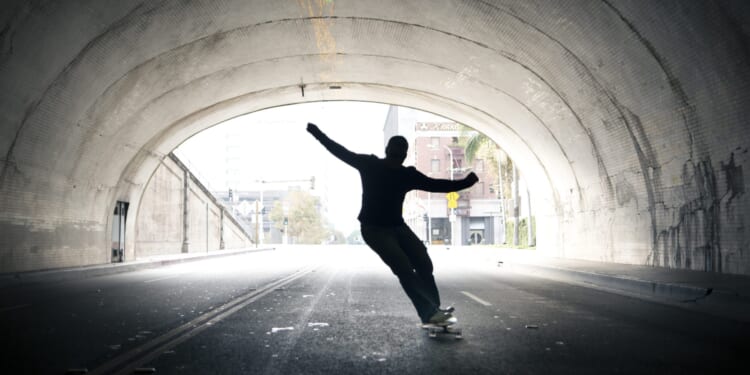One of my favourite YouTube videos features a guy who is clearly a skilled stunt motorcycle rider practising controlled, nearly walking-speed wheelies in the empty parking lot of a shopping mall.
He is approached by a man with a clipboard, that universal talisman of functionaries who take themselves to be deputised on behalf of order. What the functionary says is hard to make out. But then it hardly matters, does it? It is really the clipboard that conveys the message, a mute form of authority that often has no real argument to give, and can be effective only if everyone automatically defers to it.
But our stunt rider doesn’t do this. From his helmet cam, we see him riding in a slow circle around Clipboard Man on one wheel, and you can sense that he is at ease. “Does this look dangerous?” he asks, a bit incredulously. He has a point, which is easy to grasp if you have ever been nearly killed in a parking lot by some upstanding member of the PTA backing out in her Suburban.
But Wheelie Guy then takes it to the next level. He says to Clipboard Man: “You’re just confused, and it makes you feel things.” The functionary really does seem to be stumped by this interaction.
Wheelie Guy rides off. He clearly won the battle, in some important sense, but isn’t fool enough to think the police will be hip to his higher logic.
According to that logic, it is not just that Clipboard Man’s mission is gratuitous, objectively speaking: the parking lot is empty. But the fetish of rule-following becomes its own justification, and it fills him with a lust for enforcement even when there probably isn’t, in fact, any rule to cover parking lot wheelies. At the risk of seeming unpatriotic, I have the sad duty of pointing out that this seems to be a distinctly American phenomenon. As my French friend Jean-Pierre Dupuy said to me: “You are rule worshippers”, to the point we will make up rules on the fly to cover unanticipated eruptions of the human spirit. To compensate, we keep singing a song to ourselves about being “the land of the free and the home of the brave”.
This tension between clipboards and wheelies seems to perfectly represent America’s chequered struggle with urban living and the technocratic push towards the so-called smart city. The longing for order that underlies attempts to render the city as an object of rational planning is sometimes impervious to chastisement by the stubborn realities of human behaviour.
How, then, would the land of the free embrace the idea of the smart city — the idea that the logic of interconnected electronic devices can be applied to the human landscape, with everything optimised and orchestrated by an “urban operating system”? The energy and sewage infrastructure, police protections, trash collection, the allocation of parking and street capacity, the orchestration of traffic lights, the timing of deliveries and all the other services that make a city work will be massaged by data science and achieve a kind of frictionlessness.
Of course, human beings tend to do things that are unpredictable, making them the bug in the system. But if people can be coaxed into driverless cars, it may become possible that our movements through the city can be monitored and coordinated from afar, bringing us closer to what the English philosopher Michael Oakeshott called “a glorious, collisionless manner of living”. He was naming the ambition of a certain modern character-type, whom he called “the rationalist”.
Transformative urban planning has long been an ambition of the high-modernist mindset. Its goals are usually public health, efficiency, beauty and something more elusive — order. Some cities that have received the full treatment over the past two centuries are wonderful places to visit despite their controversial remakings; see Paris (much of it demolished and rebuilt by Baron Haussmann under Louis Napoleon in the 19th century). Others, like Brasilia and Chandigarh (both designed from the ground up by Le Corbusier), quickly became ghost towns, full of high-modernist buildings and plazas of impressive conceptual ambition through which the wind whistled forlornly, eventually to be repurposed by squatters or stripped of building materials for use in the surrounding shanty towns where urban life carries on in defiance of the master plan. Such projects are sometimes sited in the developing world because they have no robust tradition of self-rule, and therefore offer no organised resistance to the plans of these Western visionaries. Le Corbusier offered his services as a planner to Western authoritarians — both the Vichy regime and Stalin’s USSR — before hitting upon this strategy of siting his projects in the developing world.

There is something in the technocratic visionary that is too easily tempted into a moral-intellectual space that floats free of the empirical, and has more in common with the non-falsifiable commitments of a cult. And while these grand visions are easy to criticise on these grounds, it is usually the small-bore, uncoordinated attempts to assert control that, cumulatively, can lead to a clampdown on the human spirit in urban spaces. Yet, precisely because of the petty-tyrant character of such clampdowns — the obvious fact that they are clampdowns — they may summon a response in certain bold souls that is beautiful to behold. Like Wheelie Guy.
The rapper Lupe Fiasco understands this. It’s there in his beautiful track “Kick, Push” — the story of an urban kid who comes to maturity through skateboarding, and in doing so, encounters clipboard authority.
Since the first kick flip he landed
Labeled a misfit, a bandit
His neighbors couldn’t stand it
So he was banished to the park
Started in the morning
Wouldn’t stop till after dark
Yeah when they said it’s getting late in here
So I’m sorry young man there’s no skating here
The kid meets a girl skater; she takes him to a spot in a parking lot he didn’t know about, and they grind it until “security came and said there’s no skating here”. They become part of a crew. They get chased out of office building plazas. “Just the freedom was better than breathing.”
Coming of age, fugitive love, solidarity: getting chased off by “security” plays a role in creating the dissident bond. What a shame it would be if there were no Clipboard Men to heighten the experience of freedom! Like Wheelie Guy, the protagonists of “Kick, Push” confront the forces of order personified: functionaries who are nonetheless flesh and blood, giving chase to kids on skateboards and probably relishing the chase for human reasons of their own. What becomes of this human drama — the drama of freedom — when order is rendered algorithmically? Where is the fight? It is submerged and illegible. It already happened, somewhere else, and the skaters were not party to it.
Sometimes urban spaces are designed to forestall moments like those depicted by Lupe Fiasco, making the explicit intervention of “security” unnecessary because the possibilities of use have been more rigorously constrained by the design itself. Thomas de Monchaux writes of “the taste for order” that prevails when public parks, for example, come to be funded by private interests. It is natural to suppose this is driven by liability concerns, but the taste for order tends to slip the bonds of any such calculation and become a kind of murky moralism: not something openly avowed but rather taken for granted, hard to grab hold of, and therefore hard to contest.
Monchaux writes about the High Line in New York City, a wonderful park created with private financing out of an elevated railway that had long been out of service. He gives the park its proper due, but then notes that “its defining detail is the prim arrangement of metal pins and ropes that enforce the border between paving and planting. They seem to say: Do not wander, do not play, do not fool around.”

Perhaps such features have a legitimate safety rationale to them (stepping off the deck and into the flower beds, a distance of some six inches, could cause you to twist an ankle). “Yet there is also something in this regulation that goes beyond defense against the worst possibilities, toward a discouragement of all the benign irregularities — the unruly felicities, creative improvisations, leisurely inefficiencies and insouciant eccentricities — that are the heart of urban life.”
Monchaux connects the design of public spaces to political culture:
“In our liberal democracy, any occupation of public space — even, sometimes especially, at play — is a celebration of the rights of assembly and expression. The greatest success of parks and plazas is… in the ways that, as a matter of policy and design, they encourage the taking of liberties.”
This is what skateboarders represent, and more. They take a plaza not as a mere empty space for assembly, but as a constitutive element of their activity. Its hardscape features define specific challenges; they develop a repertoire of skills that may be specific to the place. They appropriate it for purposes that were never intended but are latent in it, lying dormant as affordances to be discovered by people who roll. Their “misuse” has a revelatory quality.
Understood this way, skateboarding easily lends itself to being viewed as performance art. But this would be to risk misidentifying skateboarding with the feckless “subversive” aspiration of art people. I think it is more instructive to view urban skating as an expression of civic republicanism, if one may apply a stodgy-sounding term here. Consider Monchaux’s parenthetical remark that the best parks and plazas encourage the taking of liberties “as a matter of policy and design”. Yes and no. If the liberties in question are to be actively taken (for that is what is impressive about the skaters), rather than prescribed, the “encouraging” must have a minimal quality to it. Such is the tactful quality required of the design, and it is a quality characteristic of liberalism as originally understood: securing the minimal conditions for living together, and a bit more, but not trying to control everything.
Liberalism too easily slides into something more ambitious, and by that measure less liberal. Public spaces that feel unadministered seem to be vanishing. If the “policy and design” of parks and plazas is to be modest, deliberately under-determining of the uses that might be found for them, the designer must refrain from precisely that which is most exciting to intellectuals: a comprehensive vision. Such visions invariably clamp down on play, because play insists on making its own rules, internal to some game that is “for us” as Johan Huizinga pointed out in Homo Ludens: A Study of the Play-Element in Culture. That is, for we who are right here right now. The skaters definitely have a sense of this “we”.
In assessing the smart-city vision, then, we need to keep one eye on how well the proposed order will leave room for those sources of unplanned urban delight so well named by Monchaux: “unruly felicities, creative improvisations, leisurely inefficiencies and insouciant eccentricities.” What if Clipboard Man is to be installed in an opaque, proprietary “urban operating system” that is highly determinate, an “efficient, one-to-one mapping of activities to facilities” in which parking lot wheelies do not compute? How is this clampdown likely to reverberate through society? Will it modify the liberal inheritance that we take for granted? Whose vision is this, anyway?
Writing in Tablet, Jacob Siegel points out that “democratic governments think they can hire out for the basic service they’re supposed to provide, effectively subcontracting the day to day functions of running a city and providing municipal services. Well, they’re right, they can, but of course they’ll be advertising why they’re not really necessary and in the long run putting themselves out of a job.” There is real attraction to having the tech firms of Silicon Valley take things over, given the frequent dysfunction of democratic government. Quite reasonably, Siegel writes, many of us would be willing to give up “some democracy for a bit of benign authoritarianism, if it only made the damn trains run on time. The trade-off comes in the loss of power over the institutions we have to live inside.”
The issue, then, is sovereignty. In the late 2010s, Google’s Sidewalk Labs planned to build a model city within Toronto, a sort of Bonsai version of what is possible, conceived in the spirit of other demonstration cities that were intended to sway elite opinion. The most famous of these is perhaps Potemkin’s village that so impressed Catherine the Great. Sensors would be embedded throughout the physical plant to capture the resident’s activities, then to be massaged by cutting-edge data science. The hope, clearly, is to build a deep, proprietary social science. Such a science could lead to real improvements in urban management, for example by being able to predict demand for heat and electricity, manage the allocation of street capacity based on demand, and automate waste disposal. But note that hoarding the data collected, and guarding it with military-grade secrecy, is key to the whole concept, as without that there is no business rationale. The project was cancelled in 2020 due to local opposition over the matter of “data privacy”, which could just as well be named “data ownership”.
James C. Scott’s Seeing Like a State, is useful given Google’s governmental aspirations. In the 1988 book, Scott traces the development of the modern state as a process of rendering the lives of its inhabitants more “legible”. The premodern state was in many respects blind; it “knew precious little about its subjects, their wealth, their landholdings and yields, their location, their very identity. It lacked anything like a detailed ‘map’ of its terrain and its people”. This lack of a comprehensive view put real limits on the aspiration for centralised control; the state’s “interventions were often crude and self-defeating”. The rise of a more synoptic administrative apparatus in the 18th century made it possible to improve the delivery of services and the keeping of records, mainly for the purposes of taxation and military conscription. Enhanced legibility also led to a new way of viewing society, as a system that is intellectually graspable. As such, it becomes an attractive object to the gaze of visionaries, and invites intervention. The more rigorous the vision, and the more confidence it inspires in those who share it, the more the intervention seems to demand that a blank slate be prepared for the master strokes.
This same urge might explain the impatience of the smart city urbanist, née venture capitalist, who told The New York Times that “human beings currently live in cities that are the equivalent of flip-phones”. There’s a keen sense of waste; our sheer lack of optimisation offends. Another investor-urbanist, a Mr Huh, complains: “We have not affected the fundamental building blocks of infrastructure and society.” The Times reporter writes that Mr Huh gestured to his laptop and said: “We’ve made this better. We’ve made the new things better. We haven’t made the old things better.” In a helpful gloss, the reporter points out that in thinking about how to make the old things better, “people in tech prize ‘first principles’, a concept that suggests that historical awareness and traditional expertise can get in the way of breakthrough ideas”.
Here we see the old drama of modernism playing out one more time. The urban blank slater reminds us of Thomas Hobbes’ disgust with the customary or common law, that body of precedents and practices that ordered English life, but which appeared to his impatient mind as a sediment of inherited mindlessness. For him, life needed to be governed by laws that would be excogitated from scratch (by him), according to clear principles, not by the haphazard accumulation of informal usages and understandings. Rather than seeking the reasons latent in our unthought practices, and from them trying to reverse-engineer the logic of a city, the smart city epigones of Hobbes place their trust in their own powers of a priori reason.
But governing by syllogism doesn’t work very well. For one thing, the sovereign forfeits that easy, habitual law-abidingness that custom secures. As Thomas Schrock said in his critique of Hobbes: “We follow customary laws, not out of fear, but because they are here with us, our own, part of us.”
Governing by syllogism, on the other hand, requires heavy police work. Call Security!
















